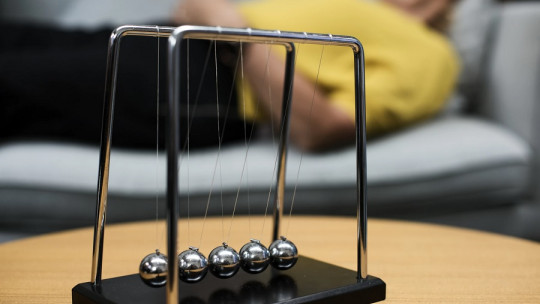Tics can be behaviors that, although simple, can imply a significant degree of discomfort in the person who manifests them.
It is for this reason that in psychotherapy we usually work on them based on the habit reversal technique , a tool that allows you to introduce a behavior that prevents the appearance of the tic or unwanted habit. Let’s see what this technique consists of.
What is the habit reversal technique?
The habit reversal technique is a type of behavioral therapy that It has been shown to be very effective in the extinction of repetitive behaviors, harmful habits and tics
This technique was originally developed by N. H Azrin and RG Nunn, and is usually used in those people who carry out actions that are problematic for both their physical and mental health, in addition to involving a high degree of intrusion in their social life. Among these problematic behaviors we can find all types of tics, hair pulling (trichotillomania), nail biting (onychophagia) or skin picking. The therapy is appropriate for any age group and socioeconomic background.
It is a procedure that consists of five phases that add up to a total of eleven techniques, in accordance with the proposal proposed by Azrin and Nunn in 1973.
1. Awareness
In this phase it is done that the person becomes aware of the stimuli and situations that can promote the appearance of a harmful tic an unwanted habit or pattern of behavior that causes some type of harm to him or her and others.
It is here that a detailed description of the behavior to be extinguished is made, and training is encouraged that makes the person take a voluntary solution to the problem.
In addition, the person is trained to become aware of when the tic is occurring, and to know how to detect the antecedents that promote its appearance.
2. Relaxation training
Habits or tics may be common when the person is in a period of high stress
It is for this reason that it can be very useful to learn skills that contribute to relaxation, such as deep breathing, imagining pleasant places, mindfulness or techniques such as yoga and meditation.
3. Training in making a response incompatible with the habit
In this phase the person is made to develop non-harmful behavior that prevents the appearance of the habit that you want to extinguish.
To do this, the new behavior must have the following characteristics:
4. Motivation
This phase It is aimed at both the patient and his or her close circle, usually his or her family
It reviews the inconveniences caused by the tic or habit-problem, in addition to promoting social support, getting one or more people around you involved and helping in the success of the therapy.
5. Generalization training
It involves performing exercises in which the patient you must imagine performing the technique in dangerous situations identified in the first phase
Disorders in which it is used
The habit reversal technique It is usually used in any disorder in which there are tics It must be understood that a tic is a series of movements, more or less involuntary and repetitive, or inappropriate vocalizations that are not typical behaviors for the contexts in which they occur.
Tic disorders represent a group of interrelated disorders, which include Tourette syndrome, Obsessive-Compulsive Disorder, and other anxiety disorders, such as generalized anxiety, social phobia, and post-traumatic stress disorder.
However, this therapy is especially useful in trichotillomania and onychophagia, behaviors that, although depending on the degree to which they occur can be considered more or less serious, are, in essence, tics. This technique has proven effective in avoiding these behaviors, which imply very variable degrees of damage to the person’s life.
Use in trichotillomania
Trichotillomania is a disorder in which the person suffers from a chronic compulsion to pull out their hair, which implies noticeable hair loss, as well as stress and social problems. In this behavioral disorder Not only is the hair pulled out, but a ritual is also usually performed with the hair pulled out such as eating the root, palpating it with the lips, or pulling out another hair that “meets the desired characteristics.”
Although it may seem like an infrequent and somewhat strange problem, the truth is that it is one of the most common pathological behaviors, with a prevalence between 0.6% and 2.5% of the general population. It is especially high in high-stress groups such as people with psychopathology, university students or very neurotic people.
This is why the habit reversal technique is usually used with people who manifest these types of tics. In this particular case, The patient is made to see why they choose to pull out their hair, relate how stressful situations occur and what makes them choose this behavior and not for a healthier one, such as chewing gum or trying to relax. It is about incorporating a behavior that prevents the person from pulling out their hair.
Use in addictions
This technique is also used in situations where there is dependence on substances , as is the case of addictions, since the patient, aware that he has a problem and must overcome it, consciously tries to stop using. However, there are certain behaviors that are difficult for him to overcome, either because he believes they are unrelated to his problem or because they are so automated that there is no way for him to extinguish them.
Among these behaviors we could find, for example, lighting a cigarette in the same way as he did with a “joint”, entering the same bars where he got drunk, although now he only had breakfast, maintaining relationships with those people who liked him. introduced into addiction…
These problems are usually the subject of intervention in addiction treatments, but many times they are not taken into account in due consideration, thus A series of factors that can cause a person to fail in their fight against substance use are being ignored or underestimated
This is why the habit reversal technique can be useful in the therapeutic approach to these behavioral patterns that lead to a relapse into addiction. Although, as we said before, it is focused more on chronic tics, it can also be useful when it comes to extinguishing those behaviors that predispose you to use again.
Habits are incorporated that prevent the person from consuming, such as drinking a glass of water when they feel like drinking or smoking, making them play an instrument, chewing gum…









